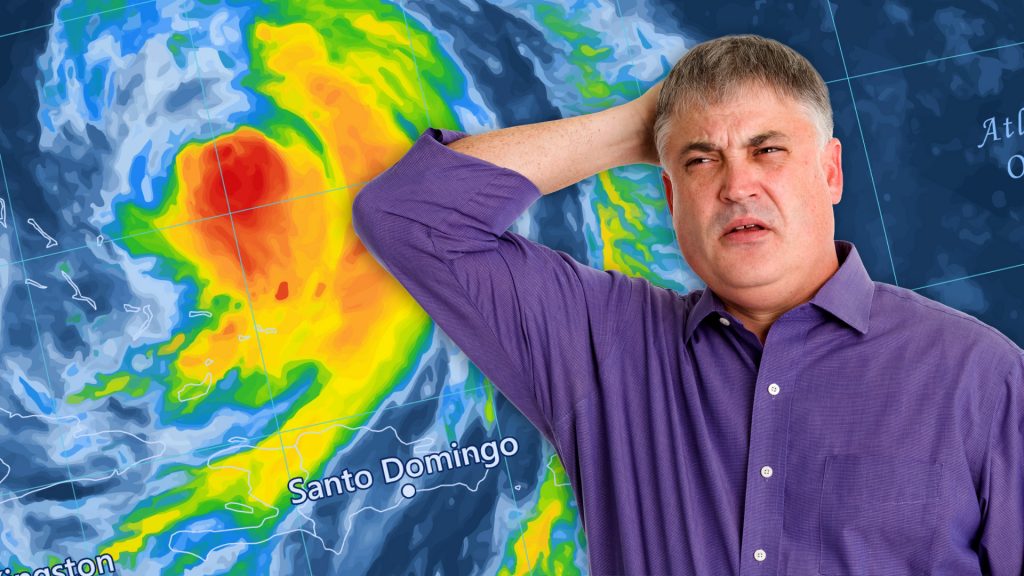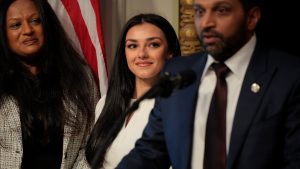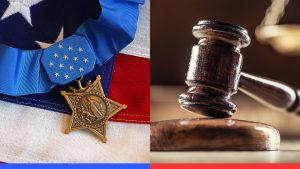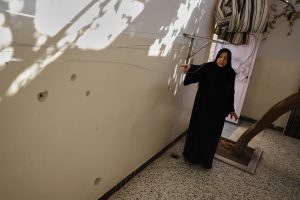Predicting weather isn’t an exact science. Here’s why many forecasts miss

Weather forecasters were preparing. They knew severe storms would hit Rochester, Minnesota, and the surrounding areas in the late-night hours long after the summer sun set on July 28.
“That’s kind of the worst-case scenario for meteorologists, when you have these strong thunderstorms capable of producing 80 to 90 mph winds and spin-up tornadoes,” KTTC Chief Meteorologist Nick Jansen told Straight Arrow News. “To have that after dark, when you can’t really get spotter reports, people are sleeping, so we have to worry about how we communicate.”
Stormy Monday night
Just after 11 p.m. — during Jansen’s broadcast hours — he was seen on camera texting on his cell phone.
“Sorry, I just had to text my wife,” Jansen told his audience. “The baby was sleeping well tonight. And that’s gonna be over.”
Not everyone took it well.
“That he has to call his wife to make sure she takes the baby to safety,” one viewer wrote, according to a Facebook post by Jansen. “Maybe some people think it’s noble or cute. I don’t.”
“That’s not me being unprofessional, it’s me being human,” Jansen responded in his post. “I am a husband and a father FIRST. Let’s all try to show each other a little more understanding and respect in life.”
That response went viral, gaining more than 16 million views. While the moment drew attention, Jansen said it wasn’t the first time he had communicated with his wife while on air.
“I don’t live too far away from the station, and a couple years ago, we had to take shelter at the station,” he told SAN. “So I just real quick said on-air, ‘Hey, Angie, if you’re watching, just make sure that you head to the basement too.’”
Jansen also received criticism after that incident. But despite negative feedback, the station and most of the community were supportive.
“We are community members. What’s impacting you at home is impacting my family too,” Jansen told SAN. “So it adds pressure for us in those severe weather moments.”
Why meteorology
Like many meteorologists, Hutch Johnson’s fascination with atmospheric science started young.
“I grew up in Billings, Montana. There was a tornado warning, and I was the kid running outside looking up at the clouds,” Johnson told SAN. “I saw my first funnel cloud.”
Later, a broadcast meteorologist visited his high school class in the Denver metro area.
“I was hooked,” Johnson said. “That’s when I thought this might be a fun way to do my love of speaking and talking, along with the science of meteorology.”
Johnson’s career path took him from research meteorology to broadcast work in Upper Midwest cities, including Fargo, North Dakota. He’s since gone independent with “Hutch’s Weather,” providing forecasts for North Dakota and Minnesota on social media.
“As a meteorologist, the goal of the whole science is to save lives and property — to give people information to make choices for their business and daily activities,” Johnson said.
In July, flash floods ripped through the Texas Hill Country, killing more than 100 people, including at least 27 at Camp Mystic, a Christian summer camp. While heavy rains were expected, state officials said the forecast fell short of reality.
“The original forecast we received on Wednesday from the National Weather Service predicted 3 to 6 inches of rain in the Concho Valley and 4 to 8 inches in the Hill Country,” Texas Emergency Management Chief W. Nim Kidd said during a July 4 briefing. “The amount of rain that fell in this specific location was never in any of those forecasts.”
Models aren’t perfect.
“Meteorology is not an exact science,” Johnson said. “It’s like going to the doctor and saying, ‘It hurts when I do this.’ The doctor says, ‘Well, don’t do that, and let’s take a look.’ Many sciences are not exact.”
How forecasts differ
Unbiased. Straight Facts.TM
A recent survey found that 68% of Americans often follow news about local weather.

Meteorologists today have more data than ever, reported through a public-private partnership.
“The public side is the government — the National Weather Service, the National Oceanic and Atmospheric Administration. The private side is weather companies, consulting firms, media,” said Brian LaMarre, who retired from the NWS after 30 years, and recently founded Inspire Weather. “We’re all using the same data to provide forecasts.”
But predictions often differ.
“If you ask five meteorologists if the hurricane will make landfall in Tampa, or if the blizzard will produce 6 inches or 12 inches, you’re going to get different answers,” LaMarre said.
Numerical Weather Prediction models crunch numbers to simulate future atmospheric conditions. They pull real-time temperature, moisture and wind data from satellites, weather balloons and ground sensors. Multiple models exist — public and private — with more in development as artificial intelligence advances.
“When we look at satellites about 22,000 miles above the equator, we have satellites on the East and West coasts constantly looking at data, 24 hours a day,” LaMarre said. “They’re spotting severe thunderstorms, wildfires, blizzards and hurricanes.”
LaMarre compared forecasting to doctors diagnosing patients: both rely on data, experience and judgment.
Dealing with bias
Meteorologists must also account for biases in models and ground-level data.
“The American model, what we call the GFS model, tends to have a bias,” said Matt Lanza, a former broadcast meteorologist who now works with Space City Weather and The Eyewall. “In urban heat island areas, it might overestimate on a day when it’s supposed to be about 100 degrees. It might say 107 or 108. We see the same thing with cold, where it overestimates how cold it’s going to get.”
Meteorologists track model performance over time and correct accordingly.
“We would also try to validate it,” LaMarre said. “I would call a weather observer or a school reporting data and ask, ‘Where is your thermometer?’ If they say, ‘It’s in the parking lot,’ that tells me it’s heating up faster. That might be useful in the winter but really bad in the summer.”
Local expertise is key, according to Johnson.
“These models don’t always understand local differences,” he explained. “That’s where someone like Hutch or other meteorologists can help. They know my area. They know Ely, Minnesota, gets colder after fresh snow. Or if a community just got 4 inches of rain, it won’t heat up as much because the sun’s energy is going into evaporation.”
Weather apps
In the digital age, people rely less on TV meteorologists and more on smartphones. But apps aren’t always accurate.
“Ultimately, your weather app is deriving information from some model,” Lanza said. “It’s either inputting one model or blending models.”
National, computer-driven models won’t factor in regional synchronicities the same way local human forecasters would.
“If you just take an app from some national vendor, there’s not a person fine-tuning that forecast for you. You’re just getting straight model output,” Johnson said. “It’s like pushing a button on “The Jetsons” machine and out pops your dinner.”
Some companies refine models to better serve the public, but others share raw data. Again, experts told SAN that it is not a perfect science.
“That’s a dangerous game, because you’re just relying on that model being right all the time in one place,” Lanza said.
That’s why meteorologists blend multiple models.
“You might take 50% of one model, 40% of another to come up with a solution you believe will happen,” Johnson said.
Weather apps gather their data the same way TV stations do — from public and private sources. For example, Apple’s iPhone app uses National Weather Service and NOAA data, plus proprietary information from the Weather Channel and Breezometer, which tracks air quality.
App forecasts are improving, particularly rain alerts, Lanza noted.
Still, experts say it’s vital to have multiple ways to receive warnings.
“It’s really important for people to have a NOAA weather radio and also a weather app they trust,” LaMarre said. “It could be a TV station, emergency management or FEMA. FEMA also has a weather app.”
FEMA developed its app with the National Weather Service, which does not yet have its own.
The post Predicting weather isn’t an exact science. Here’s why many forecasts miss appeared first on Straight Arrow News.





